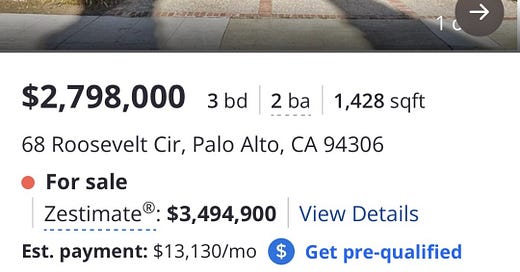A fellow on Twitter shared this house listing from Palo Alto, California a couple of days ago, which I screencapped.
There are, for a comparison of sorts, dozens of houses for sale in Detroit that are cheaper than the estimated monthly payment on this house.
I’ve seen photos showing dozens of people lined up waiting to view an open house, reports of homes selling for tens or even hundreds of thousands above asking price, and—of course—these real-estate listings from California’s Bay Area suburbs where decrepit shoebox ranch houses now about 70 years old go for $2 million, $3 million, or more.
What does this actually mean? I’m not sure it means anything. The significance of these listings isn’t that the ranch house is really worth $3 million, or conversely that it needs new flooring or the kitchen needs to be completely remodeled. Such houses are teardowns, to be replaced by much larger, more modern, and even more expensive houses.
Similarly, the houses for sale in Detroit for a few thousand dollars are not really worth $3,000 or $4,000. It isn’t exactly like you’d say, “Well, would you do $3,500?” At these kinds of extremes, prices stop communicating anything meaningful. What they’re trying to indicate is that the market thinks the land in outer Detroit is effectively worthless, while the land in Palo Alto is worth far, far more than what it’s currently being used for.
The real significance of the $3 million shoebox (or of the inverted density curve) is the deep illness to which it points. This is not about blaming homeowners; it’s just that at a high level, it’s quite obvious that something has gone very wrong. That Palo Alto listing is nonsense. It’s a “does not compute” answer that the economy spits out when we try to suppress normal market forces. It’s the American equivalent of the stories about East Germans being able to buy nothing but pickled cabbage at the grocery store, or of their automakers producing cars so awful that they were actually worth less than the resources that went into them.
Those were bits of “does not compute” nonsense that the real economy spit out, groaning under the weight of the communist planned economy. California housing prices—and those in other housing-crunched regions—are the “does not compute” effect of ours. The market is trying desperately to tell us, by spitting out such nonsense, that there are serious market failures and distortions at work. Namely, though maybe not exclusively, legacy zoning codes that have forcibly decoupled the housing market from the job market—which is to say, from the economy.
The $3 million house is a patient on a stretcher gushing blood. When he gets wheeled into the emergency room, the doctors don’t stand around and make detached observations. “Hmm, stab wound two inches from the heart. That’s a lot of blood. If we plot a chart, we can estimate that in five minutes, the patient will have lost half his blood. That would mean a 50 percent decrease in the chance of surviving the wound. But we’re not quite certain. Maybe we should produce a working paper to study this further. Then, we’ll have to do a survey of the waiting room. Their comments should be due by COB, at which point we’ll….”
That, however, is exactly what our thicket of land-use regulations forces us to do, no matter how absurd the status quo becomes. (If you don’t believe me, look what happened when a thrift store tried to lease a vacant box store in Silver Spring, Maryland.)
These places in California—and far less expensive, but still objectively very expensive places in my own region of Northern Virginia—are neighborhoods that were once middle class. They aren’t exclusive places; they aren’t Beverly Hills. The existence of expensive or even “luxury” neighborhoods isn’t the problem. The problem is that economic planning in the form of zoning has artificially turned thousands of once ordinary and affordable communities into de facto luxury communities.
I received an interesting comment the other day on one of my other housing pieces. Here’s part of it:
We are experiencing a new propagandistic “sleight-of-hand” in which corporate investors and developers openly label local residents and businesses as ‘the enemy’ of social equality and racial integration by calling them “NIMBYs” and worse. I’d like to see someone with your skills and insights take on these reconfigured expropriations for what they are underneath computer photo-shopped shiny images of new residential communities open to all, and fancy footwork by so-called progressive politicians using the rhetoric of the Civil Rights movement and perceived need for working/middle class family homes to push through their self-interested Zoning Reforms undermining social well-being. Let’s see your “take” after examining real-world demographics and shapes of small racially integrated existing neighborhoods located adjacent/near to ‘expansive’ urbanizing centers.
I think the argument here is that it’s unfair to blame legacy homeowners in expensive mature suburbs (in my region, places like Arlington, Virginia or Takoma Park or parts of Silver Spring, Maryland) for the housing crisis. This reader perceives some of this commentary as an unfair attack on such homeowners and/or on these mature communities that are, in many respects, lovely and fine-grained neighborhoods.
I agree with that to an extent—that extent being that I dislike the idea of treating mature, existing places as blank slates. I would not like to see large swaths of these older suburbs demolished for new development.
But the fact is that these houses have tripled or quadruped in value, or more, and these communities, whatever their form and their history, are now effectively closed to the vast majority of metro-area residents. Forget affordable housing—an aging one-story house in a lovely inner suburb is out of reach even for many people with upper-middle-class incomes. The opinions, motives, or work ethic of those homeowners is more or less irrelevant.
The irony is that liberalizing the zoning in these places would not necessarily change them dramatically. I wrote about this in a recent post:
If everything was constantly changing, it wouldn’t feel like much was changing at all.
Now if you hate new housing, you might hear that as me arguing for slowly boiling the frog. But that’s not the sort of point I’m making. Change and adaptation is the natural state of the built environment. Not wholesale, but gradual, low-intensity, and more or less constant. Everything from knocking down walls to double an apartment or store space, to putting an addition on a house, to building an accessory unit, to an aging house being replaced with a small multi-unit building. This kind of change is like a background hum inherent to built places, and it’s basically unobjectionable and barely noticeable….
Think of this as a sort of “law of the conservation of urban change”—you can’t stop growth, so when you try to, you end up pushing it into places where it makes less sense, costs more to build and maintain, and produces suboptimal built environments and transportation realities for people. You know those stretchy toy balls that you squeeze and part of it balloons and stretches way out? That’s what zoning inner-ring suburbs as single-family forever does to housing in a place like the D.C. area.
My argument is not that anyone’s house should be taken away or demolished. It’s not that lucky homeowners are bad or selfish. It isn’t personal at all. It’s a higher-level argument. You simply have to liberalize land use and allow the market to operate more freely, because the status quo is unsustainable and absurd. Transitions are always hard, and will always disadvantage someone, but every day we’re disadvantaging the working class, increasingly the middle class, and eventually the whole metro-area economy. (Montgomery County, Maryland first lost people, and is now losing jobs, to its northern neighbor, Frederick County, where new development is plentiful and less expensive.)
What will it cost to maintain thousands of acres of sprawling new development, 30 or 40 miles out from the urban core? Where will the city’s service workers, construction workers, and even young journalists or think-tankers live? Is it good policy to have entire metro regions where you increasingly must either choose a career or a family, but not both, because the numbers will never add up without family wealth?
All of these outcomes do not compute. You might say they’re at least the devil we know. But they’re also the devil we’ve chosen. And like so many ersatz results of economic planning and tinkering, they can be largely stopped when we so choose, as well.
Related Reading:
Still Renting After All These Years
Please consider upgrading to a paid subscription to help support this newsletter. You’ll get a weekend subscribers-only post, plus full access to the archive of nearly 300 posts and growing. And you’ll help ensure more material like this!






I'm a San Francisco resident. For decades locals have struggled with rising property prices and ever higher rents. People in other parts of the country have ridiculed us for our inability to solve these problems. Now the "solution" is to export our troubles to Austin, Nashville, Boise, Phoenix, and so on as people and money migrate and drive up costs to other areas domino style. These places are no better at managing regardless of their political leanings. At a certain point the problem will switch from an economic struggle to a political resolution. Historically these are never fun...
Florida housing prices have taken a similar turn. Siesta Key Florida. $1-3 million per house last I looked this year. Plumbers and public school teachers used to live on the island. Today, no way that would happen.